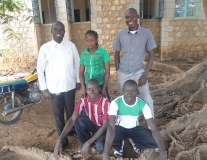- About
- Topics
- Picks
- Audio
- Story
- In-Depth
- Opinion
- News
- Donate
-
Signup for our newsletterOur Editors' Best Picks.Send
Read, Debate: Engage.
| October 12, 2016 | |
|---|---|
| topic: | Arts |
| tags: | #ethnic diversity, #Seydou Keïta, #Sudan |
| partner: | Journafrica |
| located: | Sudan |
JournAfrica: Ahmad, when and how did the idea for 1,000 Portraits From Sudan get born?
Ahmad Abushakeema: One day, I simply noticed the lack of documentation of the wonderful and beautiful varieties we have here in Sudan. And I thought it is about time to tell the world about it. As photography is part of what I do for a living, I chose the image to be my medium.
You state that showing the diversity of ethnicities, tribes and religions as well as their backgrounds is the main goal of your project. Yet, your audience does not get any information on your subjects. Don’t you think with additional information accompanying the images you could tell their story in a much better way?
I believe that the faces, costumes and backgrounds in the photos are quite enough to show the diversity we have here. Your story, your name or your nationality doesn’t matter as long as you are part of the country and its society.
What do you think this diversity that you portray through your project means for Sudan?
I believe that documentation as a culture wasn't introduced effectively throughout the history of Sudan. The misleading articulation of the cultural characteristics of the different ethnic groups in our country is massively contributing to the cultural-based conflicts. I am trying to introduce a basis for a creative documentation initiative that shouldn't be limited to photography as it can motivate different artistic projects. This notion can create a positive cultural interchange, a better understanding and liberality which are desperately needed in this community. What do you personally think the external perception of Sudan is like? I think people outside Sudan doesn't acknowledge the cultural and artistic side of this country in general and of course the diversity we have here too, I believe the image of Sudan is connected to war basically which is sadly true, but there's a lot more to know about it.
Where and how do you find your subjects?
Some of them I come across randomly around my hometown Khartoum. I then approach them and ask if they would like to become part of the project. By now there are also various people who specifically come to me, though. They have heard about the series through my website or social media and are eager to participate.
It seems that you photographed a lot more men than women so far.
That didn’t happen intentionally and there are still a lot of photos left to take. I hope to reach some kind of gender balance in the course of the project. On the other hand, this situation might be due to cultural constraints of the Sudanese society which mandates women to be more conservative than men, i.e. women are probably less often out in the streets then men.
How many photos have you taken so far?
As of now, I posted 173 images but there are a bunch that I have already taken but not uploaded yet.
When and how did you first get into photography?
That must have been about three years ago when I was inspired by images of churches as well as portraits. I decided to try and take pictures of a local church in Khartoum that I liked very much. I have been taking images of places and people ever since.
Are there any African photographers you look up to?
One of them certainly is the late Malian portraitist Seydou Keïta (1921 – 2001). I am fascinated by his way of documenting the Malian society of his time in very exquisite pieces of art.
Are there any other photographers, maybe internationally, whom you admire or draw your inspiration from?
The French street photographer Paul Almásy is a big source of inspiration for me.
What do you consider a good portrait?
An image that tells its own story without the need for a caption. It’s a matter of atmosphere and aura rather than technical know-how.
Coming back to your 1,000-Portraits project: Why do you want it to include 1,000 photographs?
By taking this amount of images, I think I can be 100 per cent sure to not miss a single detail of this country's people.
Do you already have in mind whom you will show on the very last image of this project?
Of course I do! It will be a portrait of my mother.
The interview was first published on JournAfrica!, a FairPlanet’s media partner.
By copying the embed code below, you agree to adhere to our republishing guidelines.
